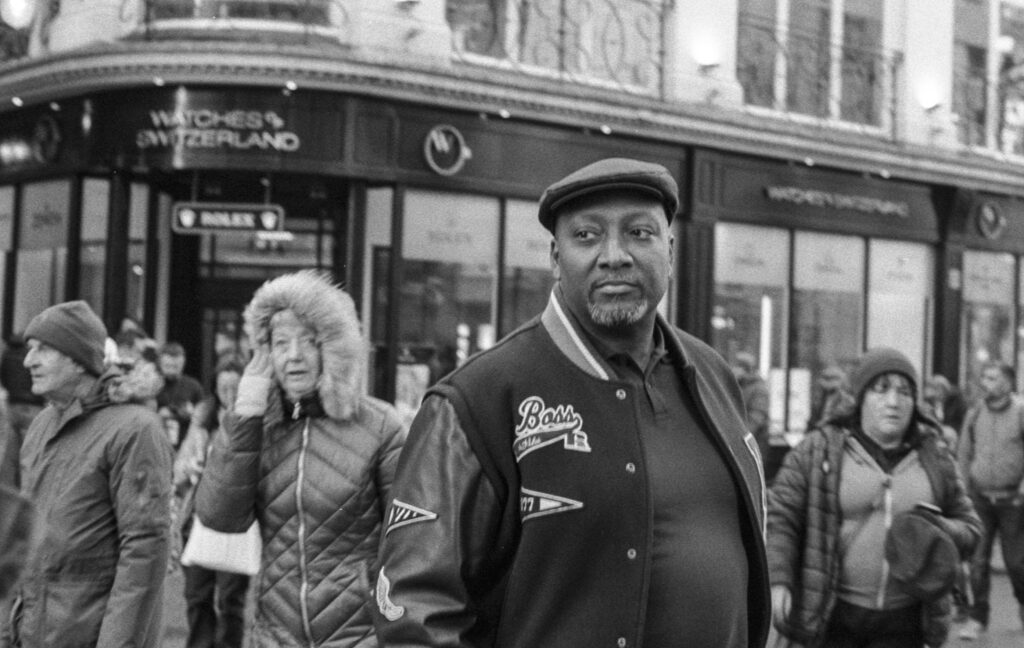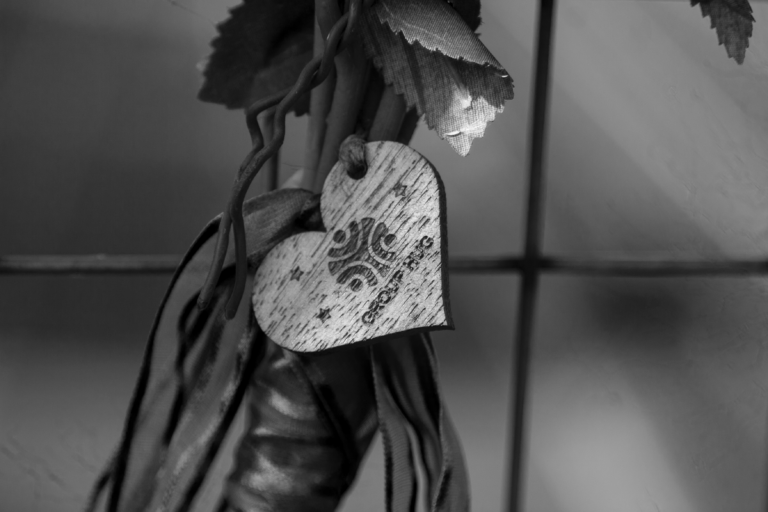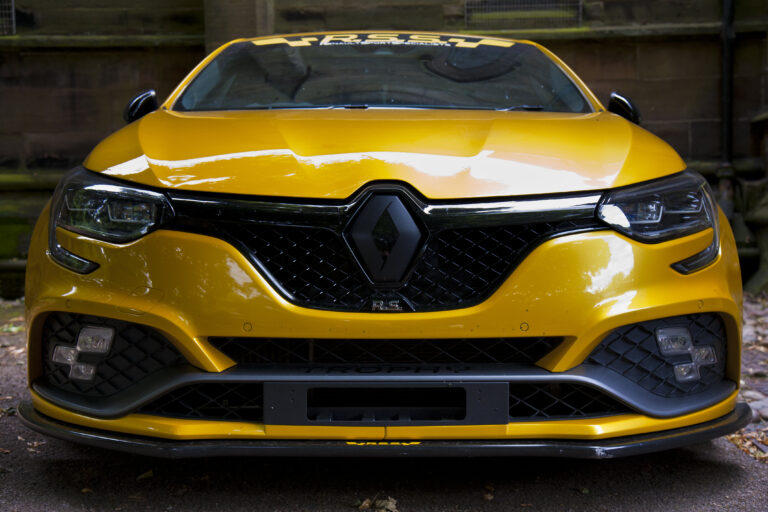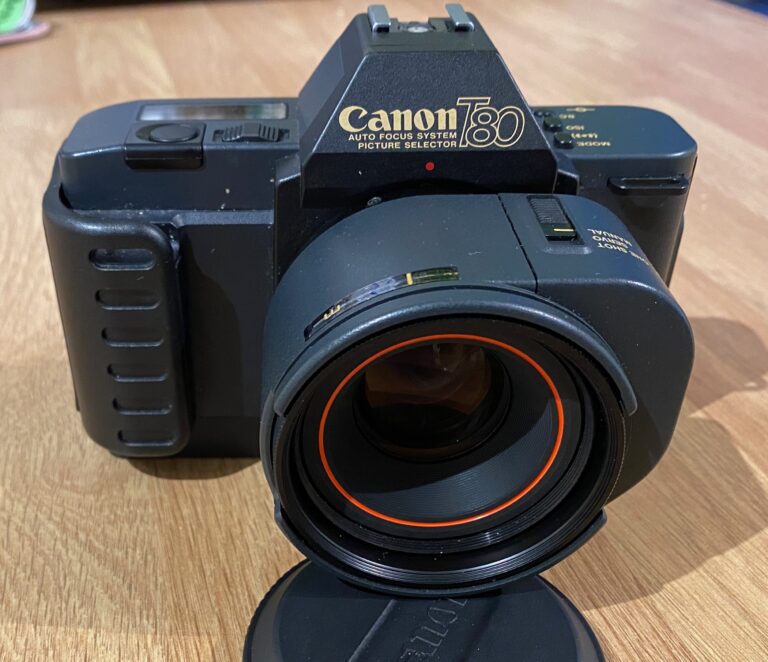Let’s be clear right from the start – this isn’t a “What’s the best camera” discussion. If you want the best of the best, and you have the bottomless pockets to fund it, then you need to buy an EOS 1V or an EOS 3. That’s it, you can stop reading and go and confidently spend your money. In terms of Canon film SLR’s there is absolutely no competition at the very top end.
However, below those two headline grabbing cameras and with a few sensible budget price points in mind, things definitely get a little trickier. Over the years, Canon introduced several “enthusiast” or “prosumer” level bodies that are available for the price of a cinema ticket now. There are also some intriguing mass market cameras introduced late on in the film lifecycle which are also well worth your consideration depending on your prospective use case scenario.
So, what’s on offer if you’re on a shoestring budget? I set out with two budget price brackets in mind, the first is super budget – £1-20 and the second is a little more extravagant at up to £40. What Canon gear can and should you buy with those two price ranges in mind? Let’s find out!
In this post:
- Prerequisites – Lenses and Development
- Bargain basement
- Bargain basement to avoid…
- For a bit more cash…
- If I had to choose just one?
Prerequisites – Lenses and Development
When buying a digital camera the chosen body can make a world of difference to the final images produced. The resolution, image stabilisation and type of sensor will all have a large say in image quality. 35mm film, however, is a great leveller. It is a cast iron fact that the same film, shot through the same lens will give you the same result regardless of which camera was used. Ultimately, a 35mm camera body has zero effect on the image other than the length of time that it decides to open the shutter. When buying digital, you’ve got to balance your budget fairly evenly between lens and camera. In the film world, I’d argue you should bias your budget way more towards lenses to begin with.
If you’ve no existing lenses, no idea what to do and you’ve got a little (and I do mean little) more to spend, I would always recommend starting with a 50mm f1.8. Prime lenses are light, simplify the shooting process and have superb optics. The 50mm lenses are amongst the sharpest ever made by Canon and that includes the cheap plastic mark 2 version of the lens. You also get the added bonus of apertures wider than the typical f5.6 and f4 offered by most zoom lenses which gives greater creative options and control. You can always buy a zoom later should you want one!

The 50mm F1.8 II was the cheapest lens Canon ever made, but just happened to be one of their sharpest. Sadly, the build quality was awful. Whilst they don’t fall apart in your hand, they are plastic throughout and wobbly too. Some suffer from back and front focus issues but if you find a good one, they’re great. However, currently on MPB.com, there is a single pound (£49 instead of £48) between one of those and the later 50mm F1.8 STM. This is effectively the same lens with much better build quality. On eBay, there is a more stark contrast in prices and the F1.8 II can be found for around £30. I’ve owned both – either will do just fine, just buy whichever is cheapest and available at the time.
The same cannot be said for the cheapest zooms available at the same price. Personally, I don’t think an ancient kit lens for £50 is going to give you anywhere near the performance that the 50mm will. If you really do want a zoom and you’re on a tight budget then I’d absolutely look to pick the lens up with the camera as some form of bundle. Invariably, this will work out cheaper. Don’t be disheartened if you can’t afford a better lens to begin with, film is far more forgiving of lens quality than digital is and some of the kit zoom lenses made in the 1990’s really were not that bad.
Finally, if you’re going to go down the film route for the first time then you’ve got to consider the cost of film and development. The fact is film photography is not a cheap hobby any more. I initially started by buying film and sending it off to be developed, however the sheer incompetence of some labs was astounding. I had a roll of HP5 developed “professionally” in 2008 and the results came back so over developed that I thought my camera was broken. This put me off film photography for a while until I decided to buy the kit to develop my own pictures. The results were game changing.
The only issue with this is that you’ll typically pay around £8-12 for film development, which is expensive. Doing it yourself, however, involves and even bigger commitment as you’ll need tanks, chemicals and a scanner which can set you back £200-300 without so much as a blink of an eye. People will now be shouting at the screen because you can “scan” negatives with a digital camera, and you can, if you already own an SLR and a macro lens. That’s a hefty whack of up-front spending and something I discussed a few years ago when looking at really, really budget options for film scanning. When you consider that a used Canon 5D Mark 2 comes in at the same price, it is definitely worth sending a few rolls off to be developed by a decent lab before making the commitment to do your own – you never know, film may not be for you!
Bargain basement
True bargain cameras are those that cost £10 or less as a body or up to £20 with a lens. Without doubt, the cheapest and most widely available Canon film body is the 1000F and the 1000FN. These cameras sold by the million from about 1990 to 1994 and were well respected. Reviewers praised the range of functions, the inclusion of as many manual modes as anyone would need and the all important musical self timer… Ok, maybe they didn’t praise the self timer, but other than the plastic lens mount which most felt would be a weakness over time (it wasn’t) there was little downside to these cheap but well built SLR’s.

Consequently, there are thousands available on the second hand market today and for as little as £1-5 you can pick up a decent copy. For a little more, and I do mean a little, at £15-25 you can easily get one with a kit lens such as the 35-80mm zoom. This combination is stunning value for money, the lens covers most focal ranges you need, admittedly you don’t get anywhere near true wide angle, but it’ll start you off and give decent image quality as you learn.

I currently own three 1000F bodies, not because I wanted or needed them but almost entirely by accident. One I bought because it was £10 and came with a lens worth more than the asking price alone, another because it came with a set of filters I wanted to try out. Strangely, despite having shot a few rolls through 1000F bodies, I’ve never sat down and written a review of them.
As entry level SLR’s go, they’re fine. The grip is nice enough, ergonomically they’re ok and they’ve got the classic Canon control layout without the quick control dial on the film door at the back. Autofocus is in the “ok” territory and will work reliably on most subjects except those which are fast moving. The speed of AF is greatly affected by the quality of lens attached – a lot of these were sold by Dixons in the 1990’s with two Sigma lenses thrown in for around £350. The Canon USM lenses are noticeably quicker and quieter, but even with L grade lenses attached the focussing ability of the 1000F is never going to blow your socks off.

Are there any other options for the budget camera connoisseur? Absolutely. Canon were masters of the bottom end of the market and released a flurry of successors to the 1000F, all of which sold well. These bodies are the 500, 500n and 300. All of these cameras are rock bottom priced, budget marvels that should definitely be on your shopping list. All three models are widely available from £5-10 without a lens and £15-25 with a lens. They are frequently sold in bundles of two or more bodies for some reason, so you may well pick up several for the price of one.

The 500 upped the specs from the 1000F by adding quicker autofocus, more AF points to use, a slightly better LCD on top and a much, much smaller body. Again, they were sold as kits just like the one above and really were all you needed to get started in SLR photography. I’ve tested a 500n a while back that was held together with duct tape and it was an absolute joy to use – I really do rate these cameras. The AF performance is really very good and the smaller body is great for carrying around for long periods of time. All three cameras see small bumps in spec from the 500 to the 500n and finally the 300. The EOS 300 has particularly good AF and introduced 7AF points at pretty much the bottom end of the market – something really quite advanced for the time.

Which camera wins at the bottom end of the market today? I’d take any of the 500, 500n or 300. The 300 is the sweet spot in terms of price to performance and really is a fantastic, compact SLR with very capable AF. The 1000F range is starting to show its age and, as always, if you can get better for exactly the same money then you should unless there’s a compelling reason to choose the older model. It’s not like we’re deciding between fully manual and automated cameras here, all the models mentioned are very similar. You should be able to pick up a used EOS 300 for less than £10 with ease, but if for some reason you can’t then don’t be disappointed with a similarly priced 500n.

Bargain basement to avoid…
Of course, you can get lots of bodies for less than £10 but that does not mean you should. Canon made several stabs at the truly entry level camera, trying to win over those who had a compact and didn’t need anything more. Cameras like the EOS 700 made use of power zoom lenses which really were awful and no quicker than just turning a ring to zoom. These cameras are all fairly limited, some have weird ergonomics and are generally disappointing in their performance and should be avoided regardless of the cost:
- 700
- 750
- 850
- 5000
- 3000

For a bit more cash…
What if you’ve got just a little more to spend? Perhaps in the £30-40 bracket? Now you’re opening up a world of options and some really very interesting, fully loaded cameras. For this kind of money you can pick up a camera that used to command a price tag of £800-£1000 and would’ve been an object of desire for many.
I’ve written previously about how much value you can get from an EOS 50 or 55, the only difference between the two being eye control focus. These are still selling for £20 at “buy it now” prices and so auction models will be cheaper still. The EOS 50 has excellent build quality, fantastic ergonomics and a nice array of physical controls for features such as metering and drive modes. The EOS 50 is a brilliant camera which will do everything you ever want unless you need fast auto focus. The AF system isn’t bad, though.

My recent experience with the EOS 5 was no better in terms of AF performance than the EOS 50 and ergonomically is a worse camera. Despite the fact the 5 was higher up in the Canon range, it is also much older and even though it’s available for literally next to nothing I wouldn’t recommend it over an EOS 50 unless you decided you wanted faster burst performance – but who in their right mind is shooting a roll of film in 5 seconds these days? Sometimes we have to be sensible and use digital.
That leaves two contenders and both will likely cost you more money. If you can find one in budget, then my absolute pick would have to be the EOS 30. This really is all the film camera you’ll ever need – it’s got excellent auto focus, superb metering, custom functions coming out of its ears, perfect ergonomics and great build quality. However, it’s becoming something of a desirable machine and people are already trying their luck with ever more stupid prices.

I’ve seen EOS 30/33’s go for around £25 recently but they’re becoming fewer and further between. If you can grab one, then do, I think they’re only going to increase in value in years to come.
My final curve ball option would be an EOS 300X. This was Canon’s final film camera and something of a hidden gem. Developing on the brilliant value EOS 300, Canon went all out with a futuristic, super ergonomic design and shrank the body down as much as they could. The design language is slightly Marmite, and I’m not a huge fan of how it looks, but when you hold it in your hand it makes total sense. This, in my opinion, is the single best SLR for travel – it’s absolutely tiny, fits nicely in the hand and equipped with a 50mm F1.8 is just a wonderfully balanced and capable combination.

The 300X has all the features you are likely to need in a camera, including easy exposure compensation and spot metering (they call it partial metering) and all with a genuinely fast 7 point AF system. The auto focus on this camera is just brilliant and for street photography I think it’s almost unrivalled. There’s only one small problem – the price.
For some reason, the 300X now attracts a price premium and you’d be lucky to get one in the £25 bracket these days. They are, however, still available for around £35 if you get lucky and so if your priority is a small, compact but fully featured camera then the 300X should be given very serious consideration. They even put the metal lens mount back on to make it more robust than the earlier 300 models…

If I had to choose just one?
I’ll finish where I started. Remember that no matter which film camera you buy, the lens you put on it matters far, far more than the body you end up with. You’d be hard pushed to find a genuinely awful lens on an EOS camera, even the kit lenses were reasonable and never scored particularly badly in reviews when they were launched. You will notice a marked improvement in image quality if you do manage to score a camera with a prime lens, usually a 50mm.
If I were on the ultimate in tight budgets and buying my first camera, I’d buy a Canon EF 50mm F1.8 Mark II (not the STM version) and aim to win one for £30-35. I’d then buy the nicest EOS 300 I could find for next to nothing and spend any remaining budget on film. You could quite possibly be in action for as little as £40 and easily for £50 including all postage and packing charges.

If that pushes the boat out too much, then I’d still stick with the EOS 300 and look to buy it complete with a lens. As we’ve seen here, it’s more than possible you could get both camera and kit lens for as little as £20 – now that truly is budget friendly.
One thing is for sure, film camera prices are starting to slowly rise for many models as the popularity of film steadily increases. The availability of new films such as Harmon Phoenix show that there’s enough demand to drive new products which will only feed the demand for these old cameras. If you want to jump on the AF film bandwagon, do it soon because there are still some absolutely crazy bargains to be had, but I do wonder how long they’ll be around for. If you are lucky enough to remember the very early 2000’s then you’ll know the same was true for manual focus bodies. I picked up an AE-1 Program for £27 back then and today you’d be lucky to get the same thing for less than £100. The time is now!
Share this post:





Great post! I agree about the EOS30, I bought one just after it came out and still have it now – my daughter just used it for her GCSE photography and it worked perfectly. She used it with the cheapo 50mm plastic fantastic and got some really good pictures. It is a great camera, has very quick and accurate autofocus, great metering, good build quality etc. I’m so glad I held onto it. When I got my fist digital SLR, a 10D, I was really disappointed with the focus speed and accuracy compared to my 30. I know Canon had to get a lot of new tech into the 10D but they dropped the ball compared to the 30 in that respect. I just looked on eBay and the prices do seem to be climbing for them and I’m not surprised as it was and still is a great camera.
I’ve also own an EOS 1000 and agree with your views own that too, though your forgot to say you get a choice of 3 or 4 tunes for the self timer 🙂 Not used that for a while as the battery ran out and I’m too tight to spend six quid just to check if something works…
I’ve got something of a soft spot for the 10D, but I used it with the benefit of hindsight and having also tried its predecessors the D30 and D60 which make the 10D AF look like it is on fire! The autofocus on the D30 is utterly abysmal and you raise a good point that I’d not thought of – the equivalent film cameras of the day had much snappier and reliable AF. Why was this?! The AF modules as far as I know were fairly interchangeable and they definitely used the same tech across multiple bodies. The only thing I can think of is it may be a processor capacity issue as the digital bodies had so much more to do than just meter and focus. Odd, though…!
I did read ages ago (like when I bought the camera, so probably over 20 years!) that the 30 had the same AF module, or a very close relative, as the 3 which would explain why it was so good. The 10D was a step backwards with a lot of talk at the time about how it would front focus. It was annoying to get pin sharp pictures out of it! The quality of the photos for a 6mp camera are superb especially if you stick a decent lens on it, but the AF drove me nuts. I think you are right, there was so much, for the time, new tech in those early digital SLRs that something had to give so I guess they skimped a bit on the AF. I think the 20D fixed quite a few of those flaws. Step forward to my 7D MK II and the AF is so complex you could say it’s gone too far the other way!
The 20D is an absolutely epic DSLR. I’d quite happily get by with one if I had to.
I was given an EOS 300 and bought the kit lens for it, cos that’s what it had when new. Never used a Canon Camera before and it won’t be my last use either. Definitely a keeper
This post inspired me to snap up a very nice condition 300V, including the 28-90mm lens and a nice little case, for the princely sum of £26.99. My last Canon was a 200D, which is now away on extended loan, and although I wasn’t thrilled with the image quality from the ubiquitous EF-S 18-55mm, I missed its light weight and “under the fingers” ergonomics. The 300V has a compact yet uncluttered layout and feels great in the hands.
The 300v is a great little camera and a bargain at £27. Enjoy!